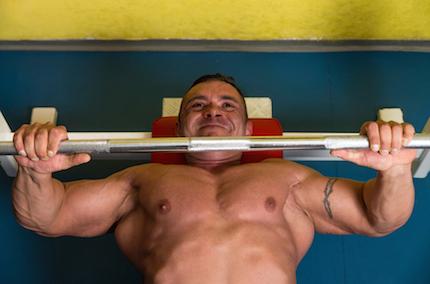Sports Medicine


Bench Press Shoulder Pain and How to Get Rid of It
One of the most common pain patterns seen in the gym today is painful shoulders when bench pressing. It can be either one shoulder or both, and it seems to come out of nowhere. One day, you’re repping your max weight, and the next day, you have problems lifting a coffee cup and the pain stays for days and weeks regardless how much rest you give it or Tiger Balm you put on it. The biggest impediment to muscle and strength gains in the gym is either a painful dysfunction or an injury. Here are the three most common bench press shoulder pain syndromes and what you can do to treat them yourself, as well as how a chiropractor or therapist will treat them.
1. Bench Press Anterior Deltoid/Pec Strain: This is a common bench press injury with the anterior delt and pec becoming potentially shortened, weak, and painful. A simple test is whether you can bring your hand backwards past your shoulder as though you were going to get something out of the back seat of the car. If you can’t bring your arm back that far or it’s painful, you may have this injury.
Self-Treatment: Doing a pec stretch will help if it’s a mild strain. Doing self massage with soap on the pec in the shower in a pec stretch position will help even more.
Chiropractor/Therapist Treatment: The most common treatments for soft tissue injuries are Active Release Technique (ART), Graston Technique, deep tissue massage, percussion, laser, and acupuncture. One or a combination of these will help heal the injury.
2. Bench Press Subscapularis Strain: This is a common hidden bench press injury where most people don’t know which muscle is injured, but it’s the rotator cuff. The subscapularis is a rotator cuff muscle that is responsible in bringing your arm downwards in a swim stroke or throwing a ball. It’s also responsible for holding the head of the humerus (shoulder joint) in the proper position as you are bench pressing. If that muscle becomes strained, the head of the humerus goes forward as you are bringing that bar down to your chest, causing pain in the front of the shoulder. A simple test is whether you can do a double biceps pose and then rotate your arms to bring your hands farther behind your shoulders. That is testing your external rotation.
Self-Treatment: If you have a mild strain, an external rotation stretch will help.
Chiropractor/Therapist Treatment: The Active Release Technique subscapularis treatment is the gold standard for this injury. Chronic injuries will also respond well to acupuncture.
3. Bench Press T4 Syndrome: This hidden bench press injury is prevalent when you have full range of shoulder motion with no pain, but when you bench press, one arm lags behind when pressing off the chest and you get shoulder pain. This is a common injury with heavy benchers because all the body weight and bar weight is resting on the upper back. And the upper back also has a contributing nerve supply to the arm and shoulders. So if you overcompress the upper back and cause a joint dysfunction in the upper thoracic spine, that can cause a neurological deficit into the shoulder and arm similar to falling asleep with your arm above your head and it being unable to move properly when you wake up.
Self-Treatment: Foam roll the upper back to get the joints moving. This is a poor way to restore motion into the upper back as it’s not very specific and is equivalent to using a screwdriver handle as a hammer. It works, but not very well.
Chiropractor/Therapist Treatment: The chiropractic adjustment for the upper thoracic joints and ribs is the gold standard treatment for this injury since it’s very specific.
So, if you have one or all of these painful shoulder bench press syndromes, try these self-treatments. If they don’t work, find a good chiropractor or therapist who specializes in weight-training injury treatments. Videos of these tests and treatments can be found at weighttrainingsportsmedicine.com.
Additional training and rehab and treatment videos can be found at swisvideo.com.

